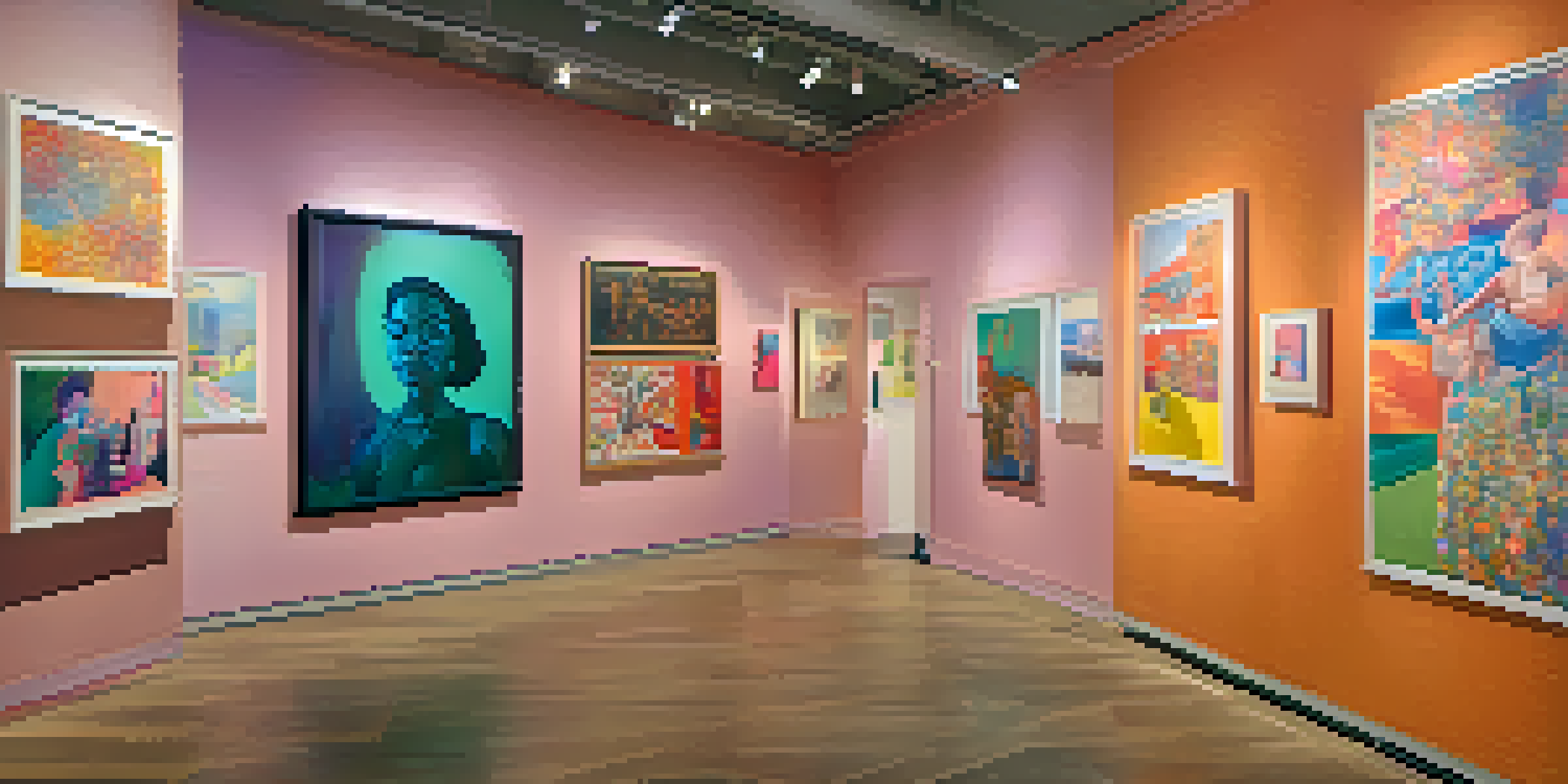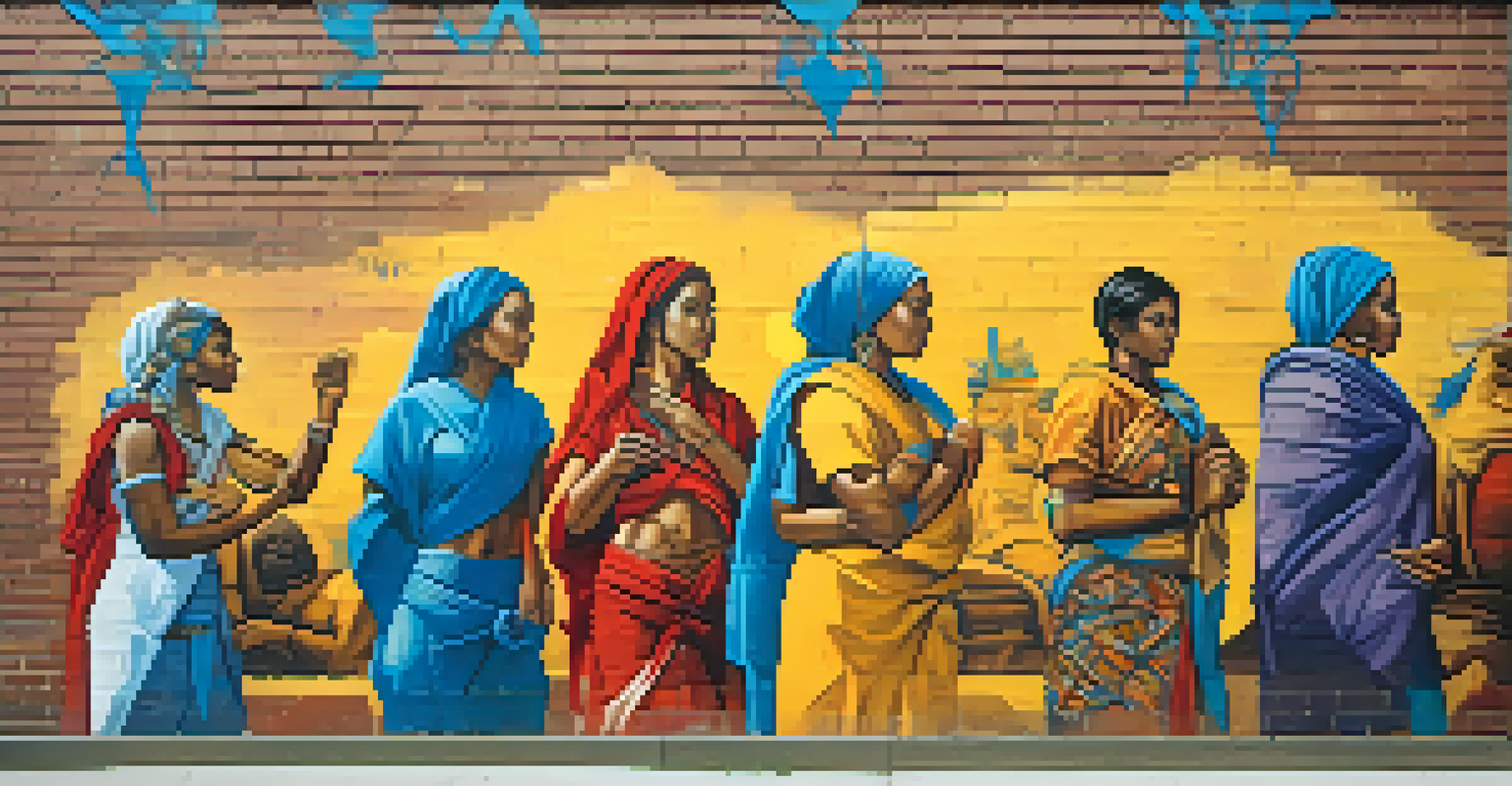Feminist Art: Challenging Perspectives on the Female Experience

Defining Feminist Art: More Than Just a Movement
Feminist art is not just an artistic style; it’s a powerful movement aiming to address and challenge societal norms about women. From the late 1960s onward, artists began using their work to reflect on gender inequality and the female experience. Through various mediums, they sought to reclaim narratives that had long been dominated by patriarchal perspectives.
The personal is political.
This art form often highlights issues such as body politics, identity, and the roles women play in society. By doing so, it creates a space where women’s voices and experiences can be openly discussed and validated. It's a rich tapestry woven from personal stories and societal observations, each piece inviting viewers to engage with the complexities of womanhood.
Many feminist artists, like Judy Chicago and Barbara Kruger, have used their platforms to inspire change and provoke thought. Their work not only resonates with those who identify as female but also invites everyone to reconsider their views on gender and power dynamics. In essence, feminist art is about empowerment and representation, making it a vital part of cultural discourse.
Historical Context: Roots of Feminist Art
To fully appreciate feminist art, we need to understand its historical roots. The late 19th and early 20th centuries saw the emergence of early feminists who began to question traditional roles and advocate for women's rights. These movements laid the groundwork for the explosion of feminist art in the 60s and 70s, when artists began using their work as activism.

During this period, the women’s liberation movement gained momentum, pushing against societal constraints and calling for equality. Artists started to challenge the male-dominated art world, creating platforms that allowed women's perspectives to flourish. This era was marked by a desire not only for recognition but also for a redefinition of what art could represent.
Feminist Art as Social Activism
Feminist art serves as a powerful tool for activism, challenging societal norms and advocating for women's rights.
In this context, works like 'The Dinner Party' by Judy Chicago became iconic, symbolizing the reclamation of women's stories throughout history. By revisiting historical narratives and inserting women into the conversation, feminist artists have reshaped how we view art and its potential for social change. This historical backdrop is essential to understanding the ongoing evolution of feminist art today.
Challenging Stereotypes: The Role of Feminist Art
Feminist art plays a crucial role in challenging societal stereotypes about women. Traditional representations often confine women to passive roles, yet feminist artists actively subvert these images, portraying women as dynamic and multifaceted beings. This shift not only empowers women but also encourages society to rethink its preconceived notions.
Art is not a mirror held up to reality, but a hammer with which to shape it.
For instance, artists like Cindy Sherman use photography to explore identity and the roles women play in society. By transforming herself into various characters, she critiques the way women are often depicted in media. Such works compel viewers to question their own perceptions and the societal norms that shape them.
By challenging stereotypes, feminist art fosters a broader conversation on gender and representation. It invites viewers to reflect on their biases and encourages a more inclusive understanding of femininity. This ongoing dialogue is vital for dismantling harmful stereotypes and promoting equality across all spheres of life.
Intersectionality: Expanding the Feminist Dialogue
Intersectionality is a key concept within feminist art, highlighting how different aspects of identity—such as race, class, and sexuality—intersect. This approach broadens the scope of feminist discourse, ensuring that diverse voices and experiences are represented. Artists like Faith Ringgold and Kara Walker emphasize the importance of including these varied perspectives in their work.
By addressing intersectionality, feminist art challenges the notion that there is a single narrative for all women. Instead, it reveals the complexities of the female experience and underscores the importance of inclusivity. This expansion allows for a richer, more nuanced understanding of feminism as it relates to art.
Intersectionality in Feminist Art
By incorporating intersectionality, feminist art expands its dialogue to include diverse voices and experiences.
Through the lens of intersectionality, feminist artists create dialogues that resonate with a wider audience. This not only enriches the art world but also encourages solidarity among different groups. By embracing these complexities, feminist art continues to evolve, reflecting the diverse realities of women's lives.
Contemporary Feminist Art: New Voices and Perspectives
As we move into the 21st century, contemporary feminist art continues to flourish, introducing new voices and perspectives. Today's artists are utilizing technology, social media, and various platforms to amplify their messages and reach broader audiences. This digital age has transformed how feminist art is created and consumed, making it more accessible than ever.
Artists like Amanda Williams and Tatyana Fazlalizadeh use their art to address pressing social issues such as racism, gender inequality, and mental health. Their works resonate deeply with audiences, sparking conversations that challenge the status quo. In this way, contemporary feminist art serves as both a reflection of societal changes and a catalyst for further dialogue.
Moreover, the rise of global feminism has led to a fusion of cultural influences in contemporary feminist art. Artists from various backgrounds are sharing their unique experiences, enriching the feminist dialogue. This diversity not only enhances artistic expression but also reinforces the idea that feminism is a global movement, encompassing a multitude of voices and stories.
The Impact of Feminist Art on Society
The impact of feminist art extends far beyond the art world; it has a profound influence on society at large. By challenging traditional narratives and stereotypes, feminist art encourages individuals to reflect on their beliefs and attitudes towards gender. This reflection can lead to greater awareness and ultimately, social change.
Moreover, feminist art has played a significant role in advocating for women's rights and social justice. Through exhibitions, public installations, and community projects, artists bring attention to issues that affect women and marginalized groups. This activism inspires collective action and empowers individuals to fight for equality.
Contemporary Voices in Feminist Art
Today's feminist artists utilize technology and social media to amplify their messages and reach broader audiences.
In this sense, feminist art becomes a form of activism that resonates with audiences, prompting them to engage with critical societal issues. As more people encounter these artistic expressions, the potential for change grows. Feminist art, therefore, is not just about aesthetics; it’s about fostering awareness and inspiring action in the pursuit of a more equitable world.
The Future of Feminist Art: Continuing the Journey
Looking ahead, the future of feminist art promises to be vibrant and dynamic as new generations of artists emerge. With the ongoing dialogue about gender, identity, and representation, there is ample opportunity for innovation in artistic expression. These artists will likely continue to push boundaries and challenge societal norms, keeping the feminist conversation alive.
As society grapples with issues like intersectionality and inclusivity, feminist art will play a crucial role in reflecting these changes. The integration of technology and digital platforms will also shape how feminist art is created and experienced, making it even more relevant in our fast-paced world. This adaptability ensures that feminist art remains a vital part of cultural discourse.

Ultimately, the journey of feminist art is not just about celebrating achievements; it’s about recognizing ongoing struggles and envisioning a future that embraces diversity and equality. By continuing to elevate marginalized voices and challenge the status quo, feminist art will remain a powerful force for change.